Weathering Climate Change
Air Date: Week of January 23, 2009
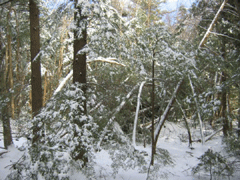
Trees damaged by an ice storm. (Photo: Robert Kluin)
No matter what we do to limit greenhouse gases now, the climate is going to change. The question is: by how much, and can we adapt ecosystems so they're better able to stand the stresses and strains of climate disruption? Living on Earth’s Bruce Gellerman hiked Massachusetts' Mt. Watatic with four experts working to prepare the forest to weather climate change.
Transcript
CURWOOD: It’s Living on Earth. I’m Steve Curwood.
The rise in greenhouse gas emissions means that the earth’s climate is already changing.
How much will vary from place to place - from profound to subtle. Some locations will suffer more severe floods and storms, other places will become drier. Some will get hotter, and some could even get colder, for a time. But while there is no way to avoid some degree of climate disruption, we may be able to help ecosystems adapt. Living on Earth’s Bruce Gellerman recently took a hike with four experts to learn what is being done to adapt one forest to the effects of a shifting climate.
[SOUND OF WALKING ON SNOW]
GELLERMAN: The air is crisp, cold and clear as John Scanlon, hikes up Mt. Watatic in north central Massachusetts.
SCANLON: Let me just get up on the high side of the tree, it’s the forester in me.
GELLERMAN: Scanlon, a forestry project leader with the state’s Division of Fisheries and Wildlife is looking for signs of climate change.
SCANLON: Here at Mt. Watatic we have examples of some of the types of forested habitats that are likely under the emerging climate change scenarios to be disrupted or potentially even lost from the commonwealth of Massachusetts, specifically spruce fir forests, which we’ll hike up to on Mt. Watatic and resident northern hardwood forests.
[SOUND OF WALKING ON SNOW]
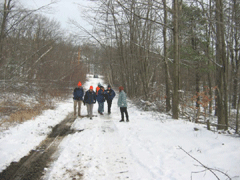
(Photo: Robert Kluin- Manomet Center for Conservation Sciences)
SCANLON: It takes a while. There we go. There we go. Once the teeth bite in we’re all set.
GELLERMAN: Oo, it smells good.
SCANLON: Yeah, right. Oh it’s great when you’re coring things like a yellow birch and black birch give off a real nice wintergreen smell.
[SOUND OF QUIET WOODS]
GELLERMAN: This tree seems fine. But biologist Hector Galbraith Director of the Climate Change Initiative at Manomet Center for Conservation Sciences says look around, and you will find evidence of warming here.
GALBRAITH: There are indicators which I think are showing fairly conclusively that we’re already seeing the sorts of ecological changes we would anticipate under climate change - changes in times of breeding and hibernation and migration schedules of organisms, I’m pretty confident that we’re looking at a climate change signal already.
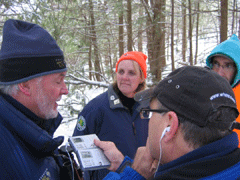
Bruce Gellerman interviews Andy Finton. In the background, from left to right: Hector Galbraith, Mary Griffin, John Scanlon. (Photo: Robert Kluin)
GELLERMAN: Joining state forester John Scanlon and biologist Hector Galbraith and me on our hike up Mt. Watatic is Mary Griffin, Massachusetts Commissioner of Fish and Wildlife. She says the department’s computer models anticipate subtle but significant changes.
GRIFFIN: They’re predicting that winters are gonna get one and a half to three and a half degrees Fahrenheit warmer than they already are, so that will have dramatic impact on habitats and fish and wildlife species. One animal that’s here in Mt. Watatic in the spruce fir habitat is the snowshoe hare, and that’s a species that the Union of Concern Scientists and other biologists predict is likely to decline as temperatures warm.
[SOUND OF WALKING ON SNOW]
GELLERMAN: Ecosystems are infinitely complex and climate change models only hint at the exquisite nature of a place. So here in Massachusetts a unique team has come together. It’s a collaborative effort, bringing together state officials, applied scientists, field researchers and non-governmental organizations leveraging their expertise and experience to find habits affected by climate change and help them adapt.
Andy Finton is director of conservation science with the state chapter of The Nature Conservancy.
FINTON: Bruce, this is - these are birch seeds.
GELLERMAN: What’s that?
FINTON: Seeds of birch.
GELLERMAN: Where did you get that?
FINTON: There’s a little birch over there. But you’ll see them scattered on the snow like this. And I certainly hadn’t thought of this until coming out here today but one of the projections is that we’ll get more precipitation as rain instead of snow. Now these birches, there are four to five species native to Massachusetts are adapted to falling on snow and blowing across that crust of snow to disperse. Now if we don’t have snow on the ground that’s going to limit the dispersal. Now, birches aren’t threatened but this is something that just came to me, about the kind of subtle network of events that could be triggered by changes to our climate patterns.
[SOUND OF WALKING ON SNOW]
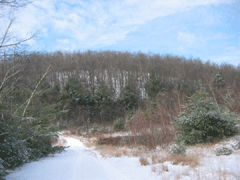
Mt. Watatic. (Photo: Robert Kluin)
SCANLON: Bruce. I wanted to stop here, and let me show you this here, We’re approaching this extensive sugar maple stand on the north side of Mt. Watatic, and you can see first hand - we’re probably some of the first people to see this - all of the obvious damage, all the tree crowns, broken from the recent ice storm.
GELLERMAN: Look at that.
SCANLON: That’s all you’re seeing, is extensive damage to the crowns of these maples from the recent ice storm.
GELLERMAN: All these trees got whacked? Oh yeah.
[SOUND OF WALKING ON SNOW]
SCANLON: And people have to understand when it comes to climate change it doesn’t have to be huge changes. One or two degrees change in temperature can mean what was going to be a snowstorm can become an ice storm giving us this tremendous damage.
[SOUND OF WALKING ON SNOW]
GELLERMAN: The ice storm was one for the books and perhaps the specter of things to come. As temperatures rise, the cold water brook trout found around here will lose its habitat and perhaps so too the Blackburnian Warbler which stops in the Watatic forest as it migrates. They’re just a few of the keystone species that call this place home, says fish and wildlife Commissioner Mary Griffin.
GRIFFIN: I just wanted to point out we’re coming upon some deer tracks. That’s white tail deer tracks in the snow.
GALBRAITH: We’ve finally gotten past the deer in the headlight stage with climate change impacts -- what’s climate change going to do to us -- and we’re beginning to think now what we’re going to do in response.
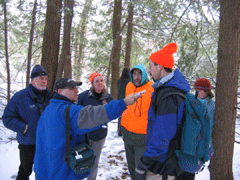
(Photo: Robert Kluin)
GELLERMAN: Climate scientists Hector Galbraith.
GALBRAITH: The state of Massachusetts has done a terrific job in preserving some of these systems. The question is how do we continue doing that terrific job in the future under climate change. This is the adaptation question.
GELLERMAN: The time for action is now, warns Dr. Galbraith, because we may not have as much time as we thought to adapt ecosystems for what’s in store.
GALBRAITH: You know we tend to think about climate change and habitat responses as long slow, linear responses; that may not be the case. There may be abrupt changes in habitats brought on by changes in stochastic events like frequent ice storms and tree damage, like increased frequency of insect attacks, like increased frequency of fire. So what we may see in the habits we’re seeing today may be steep changes rather than slow gradual changes.
Here’s a potential example. I’m not saying it will happen, but this is a possibility: The winters become warmer. The over-winter survival of tree pests, insect pests, is enhanced or the number of generations those insect populations can raise in a year is increased. So winters become warmer, more insects to attack trees. Because there’s more insect attack, there’s more dead wood, more fire –bingo - you may have a rapid transition from forested habitat to something totally different.
SCANLON: Just to add to what Hector was saying.
GELLERMAN: Forester John Scanlon.
SCANLON: Those type of changes that could occur with the greater survival of insect pests could have a direct impact on the Hemlock Wooly Adelgid, which is an invasive insect species that was introduced from Japan and has killed large hemlock cover in Connecticut. It was originally expected to sweep through Massachusetts but their progress slowed by the cooler winters. However, now that winters are warming the Adelgid are expected to cause extensive mortality of hemlock forest throughout Massachusetts.
GELLERMAN: So, you know, what if anything can you do about that kind of thing?

Trees damaged by an ice storm. (Photo: Robert Kluin)
GELLERMAN: But can you do that? Is this like a finger in the dike - I mean nature’s force is going to be so ferocious.
GALBRAITH: The trick is to increase resilience. So that when climate change comes along these systems, the eco systems might not be affected as much. So take out other stressors, contaminants, so on and so forth, and invasive species and maybe we can amplify the resilience of the effected communities.
GRIFFIN: One of the strategies we have to try to create resilient habitats is to protect large intact interior forests and blocks of land like where we are today. So the state has protected over 4,000 acres of open space and we work with partners to protect the most valuable habitats. So in protecting those habitats like the spruce fir forests or the northern hardwoods where we are today, we’re protecting places for wildlife to feed, breed and to find new resting areas and that makes them more resilient to the stressors of climate change.
GELLERMAN: But you know, right over there is New Hampshire - if they don’t do anything or they don’t do something in support of what you’re doing here in Massachusetts, can that effort just come to naught?
GRIFFIN: We’re all more interrelated by the global problem like climate change. The state of Massachusetts has been working with some of our neighboring states to protect these intact corridors with other states. We recently bought a large 5,000-acre piece of property half in Connecticut, half in Massachusetts. Last year we protected an 8,000-acre block with the state of Rhode Island. So we do work across state boundaries because biodiversity knows no boundaries.
GELLERMAN: Adapting the hemlocks at Watatic to climate change might mean thinning the tops of trees to let more light in or removing ground cover to help seeds take root. Cold-water brook trout could benefit by tearing down dams creating cooler streams.
Learning to adapt an ecosystem to the stress and strains of a changing climate also means adopting a new model for managing environments, says Dr. Hector Galbraith
GALBRAITH: I think the model we’ve created among ourselves is a really good model. A year ago, if we were having this conversation, I would have said that Massachusetts is the only place in the union who are doing this, but there are other points of light that are starting to emerge in the last six months. And I’d like to think some of those have been influenced by the work we’re doing in Massachusetts. For example Texas, the state of Texas, is now taking very seriously adaptation to climate change.
And you know, let’s be honest about this. There are some habitats we probably can’t do anything about. So there are some hard decisions coming up. You know we can all talk about here are the various things we can do but climate change is going to have fairly serious impacts on our ecosystems and we have to come to terms with that.
GELLERMAN: Climate disruption will make winners of some habits and species and losers of others. Right now, Massachusetts is creating a vulnerability index to figure out which ecosystems in the state will be adversely affected in the coming years and what, if anything, can be done to adapt them to the changing climate.
For Living on Earth, I’m Bruce Gellerman.
Links
Living on Earth wants to hear from you!
Living on Earth
62 Calef Highway, Suite 212
Lee, NH 03861
Telephone: 617-287-4121
E-mail: comments@loe.org
Newsletter [Click here]
Donate to Living on Earth!
Living on Earth is an independent media program and relies entirely on contributions from listeners and institutions supporting public service. Please donate now to preserve an independent environmental voice.
NewsletterLiving on Earth offers a weekly delivery of the show's rundown to your mailbox. Sign up for our newsletter today!
 Sailors For The Sea: Be the change you want to sea.
Sailors For The Sea: Be the change you want to sea.
 The Grantham Foundation for the Protection of the Environment: Committed to protecting and improving the health of the global environment.
The Grantham Foundation for the Protection of the Environment: Committed to protecting and improving the health of the global environment.
 Contribute to Living on Earth and receive, as our gift to you, an archival print of one of Mark Seth Lender's extraordinary wildlife photographs. Follow the link to see Mark's current collection of photographs.
Contribute to Living on Earth and receive, as our gift to you, an archival print of one of Mark Seth Lender's extraordinary wildlife photographs. Follow the link to see Mark's current collection of photographs.
 Buy a signed copy of Mark Seth Lender's book Smeagull the Seagull & support Living on Earth
Buy a signed copy of Mark Seth Lender's book Smeagull the Seagull & support Living on Earth

